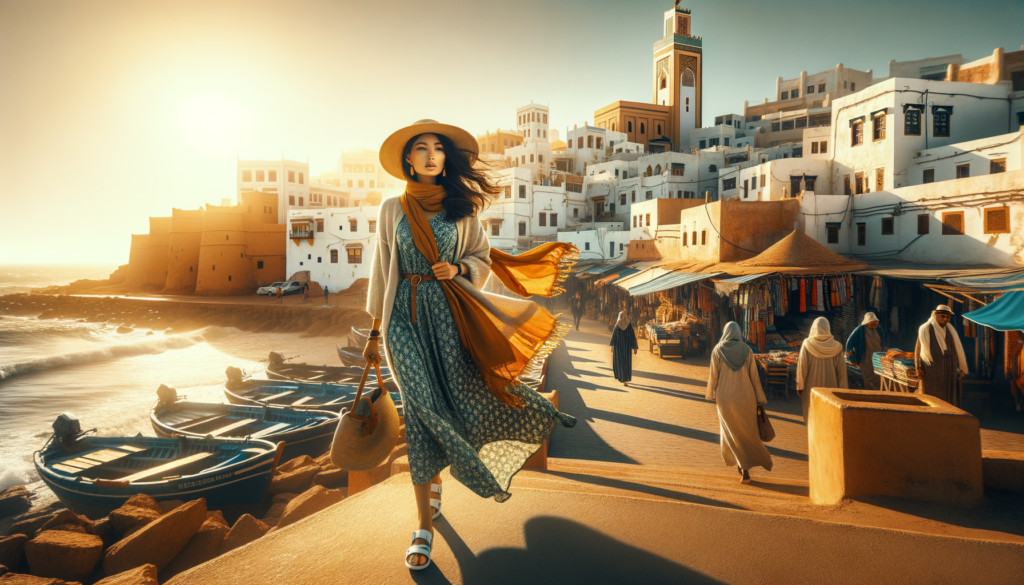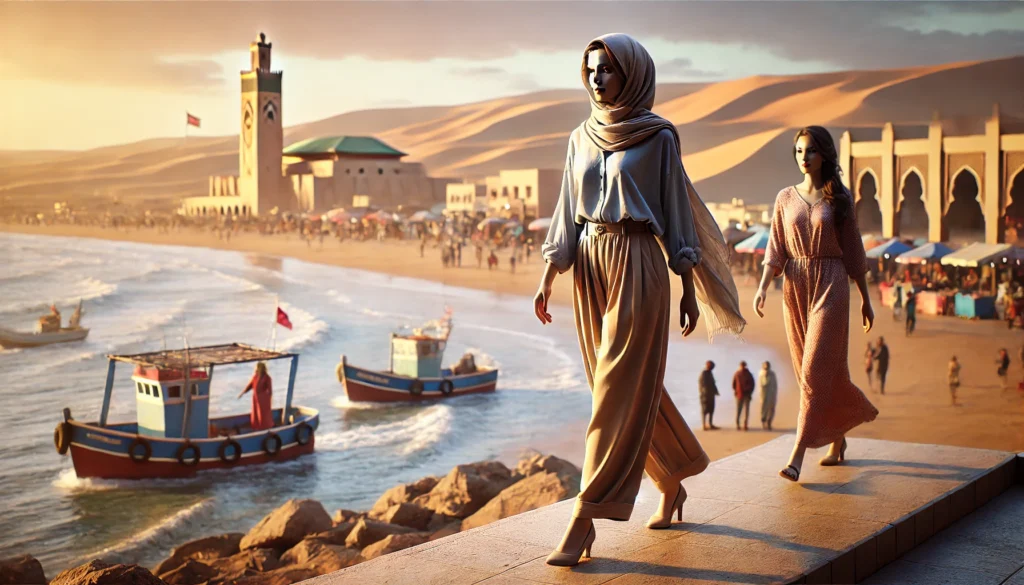
Dakhla, Morocco, is nothing short of a paradise. Nestled between the Atlantic Ocean and the mighty Sahara, this gem boasts stunning landscapes, a charming coastal vibe, and a rich cultural heritage. Whether you’re soaking up the vibrant colors of the desert or taking in the soothing sea breeze, Dakhla offers an unforgettable travel experience.
However, when planning your trip, it’s crucial to consider what to pack and wear. Not only does this help ensure comfort in Dakhla’s unique Mediterranean climate, but it also demonstrates respect for local customs. The right wardrobe is your secret to balancing style, climate adaptability, and cultural sensitivity while exploring Dakhla and its region.
Climate and the Importance of Layering
Dakhla enjoys a Mediterranean climate that brings a unique blend of sun-soaked summers and cooler winters. While the days invite travelers to bask in the warmth, the night temperatures dip, creating a sharp contrast. Understanding this temperature dynamic is key to planning your outfits for this adventure.
Summers: High Daytime Temperatures, Cooler Evenings
During the summer months, Dakhla’s daytime temperatures can soar. To stay comfortable, pack lightweight and breathable clothing like linen shirts, cotton t-shirts, and airy loose trousers. However, evenings can get noticeably cooler. A light jacket, cardigan, or shawl works wonders in helping you transition seamlessly from the sizzling sun to the refreshing twilight breeze.
Winters: Mild Days, Chilly Nights
Winter visits to Dakhla invite plenty of sunshine during the day, but once the sun sets, the air carries a chilly bite. Packing a mix of mid-weight clothing—long-sleeved tops, sweaters, and jackets—is a good strategy for layering up against the drop in temperature. Be sure to have a snug scarf or hat handy for outdoor nighttime explorations.
Pro Tip: Why Layers Work
Layering allows you to rise to any occasion—whether it’s a sweltering midday trek across sand dunes or an evening by the waterfront under a canopy of stars. Versatile layering pieces not only save suitcase space but ensure your comfort throughout the day.
Dressing Respectfully – Clothing Recommendations
When visiting Dakhla, Morocco, it’s essential to strike a balance between comfort, functionality, and respect for local customs. While the town is accustomed to tourists, showcasing cultural sensitivity through your clothing choices is always appreciated. Here are some wardrobe suggestions to help you prepare for your trip.
Loose and Flowy Clothing
The hot climate in Dakhla calls for breathable, non-restrictive clothing that ensures both sun protection and ease of movement. Opt for loose trousers, maxi skirts, tunic dresses, or kaftans. These outfits are not only comfortable but also allow air circulation, helping you stay cool during the day.
Modest Attire
Out of respect for Moroccan culture, it’s advisable to avoid overly revealing or tight clothing. Tight tops, short shorts, and miniskirts may draw unwanted attention and should be avoided. Instead, embrace modest attire like knee-length or longer dresses, capris, or palazzo pants.
Fabric Choices
When it comes to fabrics, lightweight and breathable materials are your best friends in Dakhla’s sunny terrain. Choose natural options such as cotton, linen, or rayon, which are well-suited to managing the heat while keeping you comfortable. Avoid synthetic fabrics that trap heat and moisture.
Tips for Women Travelers

As a woman visiting Dakhla, you’ll find that the city offers a welcoming atmosphere. However, adopting modest clothing is a simple way to respect local norms and ensure a more pleasant travel experience.
Cultural Expectations vs. Practicality
While foreign women are not required to cover their hair, arms, or legs, dressing modestly can help reduce unwanted attention. Aim for an attire that blends practicality with a nod to cultural expectations. Stay comfortable without feeling restricted in your personal expression.
What’s Acceptable
Feel free to wear capris, knee-length dresses, maxi skirts, or flowy trousers paired with loose blouses. Avoid very short skirts or dresses, crop tops, or overly tight clothing, especially when walking through traditional neighborhoods or marketplaces.
Travel Freedom with Cultural Sensitivity
It’s worth noting that Moroccan locals are familiar with tourists and tend to be understanding. However, dressing modestly can ease interactions, make you feel more relaxed, and reflect your acknowledgment of the local culture. Consider dressing respectfully not as a limitation but as an opportunity to engage more deeply with the community.
Exploring Traditional Moroccan Clothing
For travelers who wish to embrace Moroccan culture in their wardrobe, exploring traditional attire can be a meaningful and enjoyable experience. Traditional clothing not only provides an opportunity to connect with the local customs but also stands out as uniquely suited to the climate and lifestyle in Dakhla.
Djellabah: Versatility Meets Tradition
The Djellabah is a long, loose-fitting, hooded robe traditionally worn by both men and women in Morocco. Its breathable fabric and relaxed fit make it ideal for the region’s warm days, while the hood offers protection against the sun or occasional desert winds. Its versatility allows you to wear it casually while sightseeing or even during more formal occasions. As a tourist, slipping into a Djellabah is a stylish way to immerse yourself in Moroccan traditions.
Caftan: A Touch of Elegance
The Caftan, a flowy dress often adorned with intricate embroidery, is an especially popular choice for formal settings in Morocco. While less commonly worn in day-to-day life, it offers a chance for visitors to blend in during festive events or evening dinners. Opting for a slightly simpler, lightweight caftan can also work wonderfully as comfortable daywear while adding a dash of sophistication to your travel wardrobe.
Where to Shop for Traditional Attire
Consider exploring local souks and boutiques in Dakhla for an authentic shopping experience. Many vendors offer beautifully crafted garments that showcase Morocco’s rich heritage. Purchasing a Djellabah or a Caftan not only elevates your wardrobe but also supports local artisans and textile makers.
Conclusion
Traveling to Dakhla, Morocco, presents a unique opportunity to experience stunning landscapes, a welcoming culture, and a rich heritage. Dressing thoughtfully can make your journey even more enjoyable, blending practicality, comfort, and respect for local traditions.
By selecting lightweight, modest, and climate-appropriate clothing, you ensure that your attire bridges cultural sensitivity with personal comfort. Whether you’re layering for the daytime heat and nighttime cool, exploring the elegance of a Djellabah or Caftan, or simply choosing breathable fabrics, your wardrobe choices can enhance your connection to this vibrant destination.
As a final tip, don’t hesitate to ask locals, guides, or hotel staff for any additional advice on appropriate clothing—it’s a wonderful way to open conversations and learn more about Moroccan customs firsthand.
Above all, remember that respecting the culture and dressing comfortably will help make your visit to Dakhla an unforgettable and respectful adventure.
Frequently Asked Questions: Dressing for Dakhla, Morocco
What type of clothing is suitable for Dakhla’s climate?
Dakhla experiences a Mediterranean climate. During summer, temperatures are hot during the day but cooler at night, so layering is recommended. In winter, daytime temperatures are mild, but evenings can be chilly, so warm layers are essential.
Are there specific fabrics I should choose for clothing?
Yes, breathable fabrics like cotton and linen are ideal. These materials are suitable for hot weather and dry quickly, making them convenient for travel.
What are the recommended clothing styles to respect the local culture in Dakhla?
Loose and flowy clothing such as maxi skirts, tunic dresses, or full kaftans help respect local modesty. Avoid wearing tight or overly revealing clothing.
Do women need to cover their hair, arms, or legs in Dakhla?
No, foreign women are not required to cover their hair, arms, or legs. However, it’s best to avoid tight or revealing outfits to blend in respectfully.
What traditional Moroccan clothing should tourists consider?
You do not need to wear traditional Moroccan clothing, but options like the Djellabah (a long robe with a hood) or a caftan (a long, embroidered dress) can be stylish and respectful choices.
Are capris and knee-length clothing acceptable in Dakhla?
Yes, capris, knee-length skirts, and maxi dresses are acceptable. However, very short or tight clothing should be avoided to minimize unwanted attention.
What footwear is appropriate for Dakhla?
Choose comfortable shoes, especially if you plan to explore the city or engage in outdoor activities. Comfort should take priority over style.
Should I dress differently when visiting religious sites in Dakhla?
Yes, it’s important to dress modestly when visiting mosques or other religious sites. Covering shoulders and knees is recommended to respect local customs.
Where can I find advice on what to wear in Dakhla?
Your local tour guide or contacts can provide valuable recommendations. Additionally, online resources such as travel blogs are helpful for more detailed guidance.